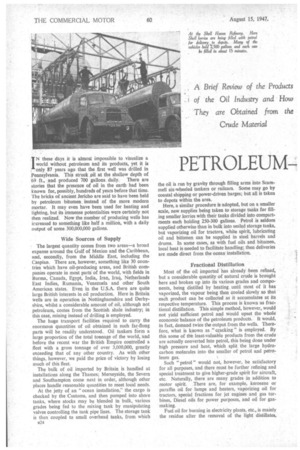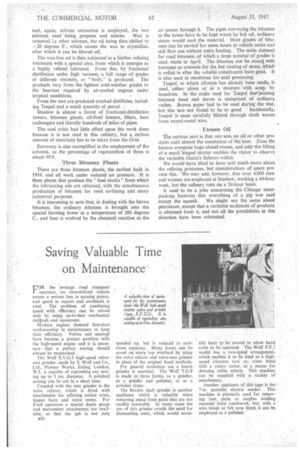PETROLEUM Uhe Qenerous
Page 34

Page 35

Page 36

If you've noticed an error in this article please click here to report it so we can fix it.
Provider
/ , N these days it is almost impossible to visualize a world without petroleum and its products, yet it is ; only 87 years ago that the first well was drilled in Pennsylvania. This struck pil at the shallow depth of 69 ft., and produced 700 gallons daily. There are stories that the presence of oil in the earth had been known for, possibly, hundreds of years before that time. The bricks of ancient Jericho are said to have been held by petroleum bitumen instead of the more modern mortar. It may even have been used for heating and lighting, but its immense potentialties were certainly not then realized. Now the number of producing wells has ircreased to something like half a million, with a daily output of some 300,000,000 gallons.
Wide Sources of Supply • The largest quantity comes from two areas—a broad expanse around the Gulf of Mexico and the Caribbean, and, secondly, from the Middle East, including the Caspian. There are, however, something like 30 countries which have oil-producing areas, and British companies operate in most parts of the world, with fields in Burma, Canada, Egypt, India, Iran, Iraq, Netherlands East Indies, Rumania, Venezuela and other South American states. Even in the U.S.A. there are quite large British interests in oil production. Here in Britain wells are in operation in Nottinghamshire and Derbyshire, whilst a considerable amount of oil, although not petroleum, comes from the Scottish shale industry; in this case, mining instead of drilling is employed.
The huge transport facilities required to carry the enormous quantities of oil obtained in such far-flung parts will be readily understood. Oil tankers form a large proportion of the total tonnage of the world, and before the recent war the British Empire controlled a fleet with a gross tonnage of over 3,000,000, greatly exceeding that of any other country. As with other things, however, we paid the price of victory by losing much of this fleet.
The bulk of oil imported by Britain is handled at installations along the Thames; Merseyside, the Severn and Southampton come next in order, although other places handle reasonable quantities to meet local needs.
At the jetty of an "ocean installation," the cargo is checked by the Customs, and then pumped into shore tanks, where stocks may be blended in bulk, various grades being fed to the mixing tank by manipulating valves controlling the tank pipe lines. The storage tank is then coupled to small overhead tanks, from which a24 the oil is run by gravity through filling arms into Scammell six-wheeled tankers or railcars. Some may go by coastal shipping or power-driven barges; but all is taken to depots within the area. Here, a similar procedure is adopted, but on a smaller scale, new supplies being taken to storage tanks for filling smaller lorries with their tanks divided into compartments each holding 250-300 gallons. Petrol is seldom supplied otherwise than in bulk into sealed storage tanks, but vaporizing oil for tractors, white spirit, lubricating oil and bitumen can be supplied in steel barrels and drums. In some cases, as with fuel oils and bitumen, local heat is needed to facilitate handling; then deliveries are made direct from the ocean installation.
Fractional Distillation Most of the oil imported has already been refined, but a considerable quantity of natural crude is brought here and broken up into its various grades and components, being distilled by heating until most of it has vaporized, the vapour being then cooled slowly so that each product can be collected as it accumulates at its respective temperature. This process is known as fractional distillation. This simple method, however, would not yield sufficient petrol and would upset the whole economic balance of the petroleum products. It would, in fact, demand twice the output from the wells. Therefore, what is known as " cracking" is employed. By this some of the least-valuable products from the crude are actually converted Into petrol, this being done under high pressure and heat, which split the large hydrocarbon molecules into the smaller of petrol and petro leum gas. 5 Such " petrol " would not, however, be satisfactory for all purposes, and there must be further refining and special treatment to give higher-grade spirit for aircraft, etc. Naturally, there are many grades in addition to motor spirit. There are, for example, kerosene or paraffin oil for lamps and heaters, vaporizing oil for tractors, special fractions for jet engines and gas turbines, Diesel oils for power purposes, and oil for gas making.
Fuel oil for burning in electricity plants, etc., is mainly the residue after the removal of the light distillates, where this has not been further treated for the manufacture of other products, such as lubricating oils.
White spirit, which is somewhat lighter than kerosene, is employed in dry cleaning, in polishes and as a substitute for turpentine. Petroleum wax renders moisture-proof milk cartons, confectionery boxes, etc. Degreasing compound provides the basis of most shampoos and is used in many trades for cleaning upholstery, paintwork, articles in perspex, and even for domestic washing-up.
The further processing of fuel oil gives useful forms of bitumen used in road construction and for many industrial purposes, also lubricating-oil distillates, which are elaborately refined before blending into some 300 qualities of lubricating oil. Even petroleum coke becomes the lead in pencils and the carbons used in electric furnaces and arc lamps. Gases from the oilfields, burnt under controlled conditions, produce carbon black, that vital ingredient of our tyres. Liquified petroleum gases in cylinders supply light and heat for our caravans and yachts.
The most striking development, however, is the creation of the chemical industry, using the gases frorn cracking as its raw material. These had previously been employed as furnace fuel. A new plant here will be able to supply many products at present imported from America and representing an expenditure of about 4,000,000 dollars annually.
Certain products are providing an alternative to ordinary soap. Propylene and butylene yield solvents exten sively used for lacquers and in the production of artificial silk and explosives. They even play an important part in the production of penicillin. Ethylene can become alcohol and is itself an anaesthetic. It can even be used for ripening fruit. Then there are the well-known ethylene glycol for anti-freeze, chloroform, artificial perfumes and flavourings, and last, but not least, plastics for pens, records, telephone fittings and many other purposes.
At the Stanlow Refinery of the Shell Refining and Marketing Co., Ltd., what are known as "topped crudes" for the production of lubricating oil and bitumen arrive by ship in huge quantities via the Manchester Ship Canal. The refinery has docking facilities for five ocean-going tankers, each carrying up to 14,000 tons, steam being provided from the shore for pumping the oil into the land storage tanks.
This splendidly equipped refinery was started about 1924, and is devoted to the production of bitumen and special-boiling-point spirits for use as cleansing spirits and lighter fluids, whilst refined lubricating oils of all classes are dispatched from here to places all over the we rid.
Blown Bitumen from Petroleum One of the latest products is blown bitumen, in which the ordinary variety is heated and mixed with air, and thus given a rubbery consistency by dehydrogenation and polymerization. It withstands sun and air and is much used for such products as rooting felt, strong paper bags, and as sealing for accumulators.
Although a small percentage of crude petroleum must be lost in the refining, and hitherto it has not been the custom to bring in much in this form, this policy is being altered and new, large refineries may soon be erected in this country to deal with increased quantities.
Lubricants and oil in general come from non-waxy Iced stock. After initial refinement, the " raw" lubricants are treated with sulphuric acid to remove oxidizing bodies, which would give gummy deposits. Fuller's earth is also used to improve the colour, and the oil passes through huge filters.
For higher-quality oils used in Diesel engines, compressors, etc., solvent extraction is employed. Here, sulphur dioxide is used to separate the top crude into two "layers "—lubricants and non-lubricants. Motor oils, in particular, come from paraffinic asphaltic bases,
and, again, solvent extraction is employed, the two solvents used being propane and selecto. Wax is removed Ly other solvents, the oil being then chilled to —20 degrees F., which causes the wax to crystallize, after which it can be filtered off.
The wax-free oil is then subjected to a further refining treatment with a special clay, from which it emerges as a highly refined lubricant. From this, by fractional distillation undei high vacuum, a full range of grades of different viscosity, or "body," is produced. The products vary from the lightest cold-weather grades to the heaviest required by air-cooled engines under tropical conditions.
From the wax are produced cracked distillates, including Teepol and a small quantity of petrol.
Stanlow is almost a forest of fractional-distillation towers, bitumen plants, oil-fired heaters, filters, heat exchangers and literally hundreds of miles of pipes.
The coal crisis had little effect upon the work done because it is not used in this refinery, but a, certain amount of electricity has to be taken from the Grid.
Ecoaomy is also exemplified in the employment of the solvents, as the percentage of regeneration of these is about 99.9.
Three Bitumen Plants There are three bitumen plants, the earliest built in 1934, and all work under reduced air pressure. It is these plants that produce the "feed stocks" from which the lubricating oils are obtained, with the simultaneous production of bitumen for road surfacing and many industrial purposes.
It is interesting to note that, in dealing with the blown bitumen, the ordinary bitumen is brought into the special blowing tower at a temperature of 200 degrees C., and heat is evolved by the chemical reaction as the air passes through it. The pipes conveying the bitumen to the -tower have to be kept warm by hot oil; ordinary steam would cool the material. Most grades of bitumen Can be carried for some hours in vehicle tanks -and still flow out without extra heating. The main dernand for road bitumen, of which a large number of grades is Used, starts in April. The bitumen can be mixedk with kerosene or creosote for the hot coating of stone, which • is rolled in after the volatile constituents have gone. It is also used in emulsions for cold processing, '
Teepol, to which allusion has already been made, is used, either alone or in a mixture with soap, by laundries. In the casks used for Teepol therajointing between head and staves is comprised of ordinary rushes. Brown paper had to be used during the war, but this was not found to be so good. Incidentally, Teepol is most carefully filtered through cloth woven from monel-metal wire.
Unseen Oil
The curious part is that one sees no oil or other products until almost the conclusion of the tour. Even the heaters comprise huge closed rooms, and only the lifting ofa small hinged shutter enables the visitor to observe the veritable Dante's Inferno within.
We would have liked to have said much more about the refining processes, but considerations of space prevent this. We may add, however, that over 4,000 men and women are employed at Stanlow, working a 44-hour week, but the refinery runs on a 24-hour basis.
It used to be a joke concerning the Chicago Meatpacking factories that everything of a pig was used except the squeak. We might say the same about petroleum, except that a veritable multitude of products is obtained from it, and not all the possibilities in this direction have been exhausted.




















































































